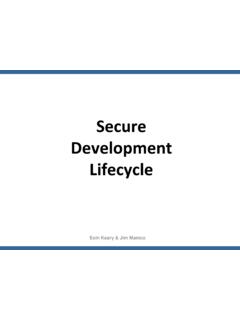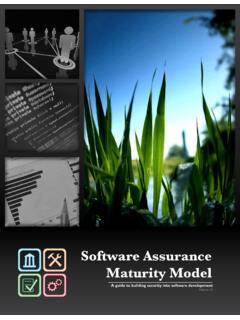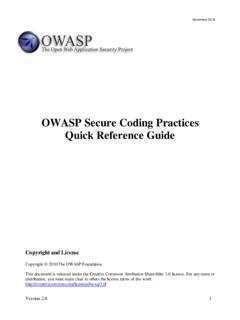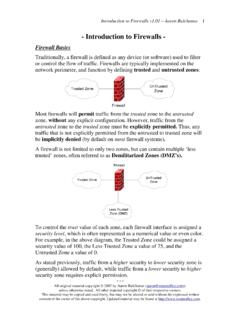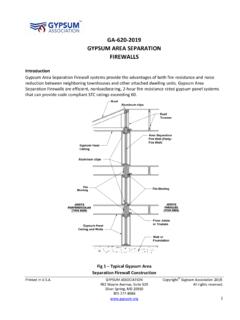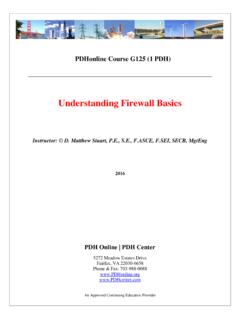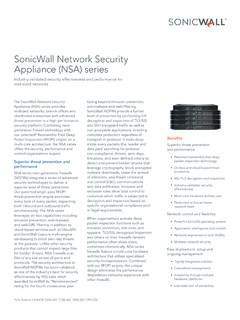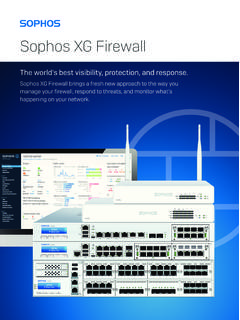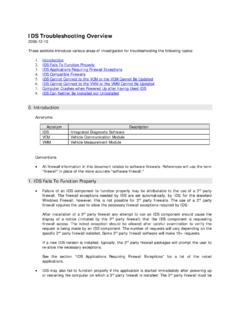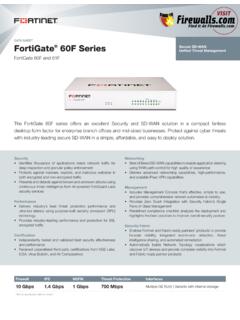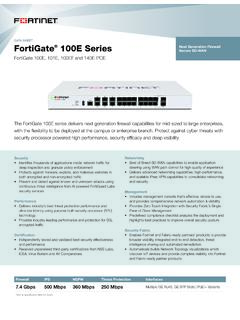Transcription of Best Practices: Use of Web Application Firewalls
1 OWASP Papers Program Best Practice: Use of Web Application Firewalls Best Practices: Use of Web Application Firewalls Version , March 2008, English translation 25. May 2008 Author: OWASP German Chapter with collaboration from: Maximilian Dermann Mirko Dziadzka Boris Hemkemeier Achim Hoffmann Alexander Meisel Matthias Rohr Thomas Schreiber OWASP Papers Program Best Practice: Use of Web Application Firewalls Abstract Web applications of all kinds, whether online shops or partner portals, have in recent years increasingly become the target of hacker attacks. The attackers are using methods which are specifically aimed at exploiting potential weak spots in the web Application software itself and this is why they are not detected, or are not detected with sufficient accuracy, by traditional IT security systems such as network Firewalls or IDS/IPS systems. OWASP develops tools and best practices to support developers, project managers and security testers in the development and operation of secure web applications.
2 Additional protection against attacks, in particular for already productive web applications, is offered by what is still a emerging category of IT security systems, known as Web Application Firewalls (hereinafter referred to simply as WAF), often also called Web Application Shields or Web Application Security Filters. One of the criteria for meeting the security standard of the credit card industry currently in force (PCI DSS - Payment Card Industry Data Security Standard ) for example, is either a regular source code review or the use of a WAF. The document is aimed primarily at technical decision-makers, especially those responsible for operations and security as well as Application owners (specialist department, technical Application managers) evaluating the use of a WAF. Special attention has been paid wherever possible to the display of work estimates including in comparison to possible alternatives such as modifications to the source code.
3 In addition to the importance of the web Application regarding turnover or image the term access to a web Application used in this document can be a good criterion in the decision-making process relating to the use of WAFs. Specifically, the access to a web Application , measures the extent to which the required changes to the Application source code are actually carried out in-house, on time,or can be carried out by third parties. As ilustrated by the graph below, a web Application to which there is no access, can only be protected sensibly by a WAF (additional benefit of the WAF),.Even with an Application in full access, a WAF can be used as a central service point for various services such as secure session management, which can be implemented for all applications equally, and as a suitable means for proactive safety measures such as URL encryption Further key topics dicussed in this paper include best practices for processes concerning the installation and operation of a WAF as well as in particular for larger companies a description of the role of the WAF Application manager.
4 OWASP Papers Program Best Practice: Use of Web Application Firewalls About .. This document has been developed by the OWASP German Chapter. The authors are employees of companys, who are consulting on the use and operation of WAFs, are producing WAFs and/or are setting up WAFs. Authors Maximilian Dermann Lufthansa Technik AG Mirko Dziadzka art of defence GmbH Boris Hemkemeier OWASP German Chapter Achim Hoffmann SecureNet GmbH Alexander Meisel art of defence GmbH Matthias Rohr SecureNet GmbH Thomas Schreiber SecureNet GmbH Terminology The specialist terms used in this document are not explained in detail and knowledge of their meaning is assumed. No glossary has been included in order to keep the volume manageable and to keep to the actual subject of this paper as closely as possible the use of Web Application Firewalls .
5 Detailed definitions and more in-depth descriptions concerning WAS Web Application Security can be found at: :Attack OWASP Category:Attack :Threat OWASP Category:Threat :Vulnerability OWASP Category:Vulnerability WASTC Web Application Security Consortium: Web Security Threat Classification WAFEC Web Application Security Consortium: Web Application firewall Evaluation Criteria OWASP WAFs When Are They Useful Licence This document is licensed under a Creative Commons attribution under equivalent conditions as the Germany licence To view the licence, please go to or send a letter to Creative Commons, 171 Second Street, Suite 300, San Francisco, California 94105, USA. OWASP Papers Program Best Practice: Use of Web Application Firewalls Contents A1 Introduction and aim of this document 5 Introduction 5 Definition of the term WAF Web Application firewall 5 Target readership and objective 5 A2 Characteristics of web applications with regard to Web Application Security 6 Higher level aspects within the organization 6 Technical aspects of each of the company s individual web Application 6 A3 Overview of Web Application firewall (WAF)
6 Features 7 Where WAFs fit into the Web Application Security field as a whole 7 Typical security mechanisms of WAFs using specific vulnerabilities as example 8 A4 Overview of benefits and risks of Web Application Firewalls 10 Main benefits of WAFs 10 Additional benefits of WAFs depending on the actual functionality of the product 10 Risks in the use of WAFs 11 A5 Security versus OWASP TOP10 a comparison of WAFs and other methods 12 A6 Criteria for deciding whether or not to use a WAF 16 Organization-wide criteria 16 Criteria with regard to a web Application 16 Evaluation and summary 16 A consideration of the financial aspects 17 A7 Best practices for introducing and operating a WAF 19 Aspects of the existing web infrastructure 19 Central or decentral infrastructure predictable changes 19 Performance criteria 19 Organisational aspects 19 Conforming to existing security policies 19 New role model: WAF Application manager 19 Iterative procedure for implementation from basic security to full protection 20 Step 1: Specification of role distribution / inclusion of Application development 20 Step 2: Basic protection for all web applications 20 Step 3: Creating a priority list of all existing web applications 20 Further steps: Full protection of the web applications according to priority 20 A8 Appendices 21 Checklist: Access to a web Application from a security-standpoint 21 Role model when operating a WAF 22 The individual roles 23 WAF platform manager 23 WAF Application manager (per Application ) 23 Application manager 23 OWASP Papers Program Best Practice.
7 Use of Web Application Firewalls A1 Introduction and aim of this document Introduction Whether the online branch of a bank, an online-shop, a customer-, partner- or employee-portal all of these web applications are available to their customers as well as their attackers around the clock due to the always on nature of the internet. Attacks such as SQL injection, cross-site scripting or session hijacking are aimed at vulnerabilities in the web applications itself and not at those on the network level. For this reason, traditional IT security systems such as Firewalls or IDS/IPS are either totally unable to guard against these attacks or are incapable of offering comprehensive protection. From a technical point of view the fundamental issue is, that the web, especially the HTTP protocol, was not designed for such complex applications which are currently state of the art. Many vulnerabilities have their origin here: for example, HTTP is not stateful, sessions or stateful applications must be defined separately and implemented securely.
8 These vulnerabilities are increased even further by the high degree of complexity of the web scripts, frameworks and web technologies frequently used. In addition to the recent introduction of industrial standards, the data security standard of the credit card industry (PCI DSS ), security breaches in Germany which have only recently been revealed, such as the loss of approx. 70,000 items of customer data incl. credit card information for online ticker dealer , have ensured an increased level of interest in possible security measures against Application level attacks. This document covers a category of security systems, the Web Application Firewalls (WAF), which are especially well suited for securing web applications which are already in production. Definition of the term WAF Web Application firewall In this document, a WAF is defined as a security solution on the web Application level which from a technical point of view does not depend on the Application itself.
9 This document focuses on the exposition and evaluation of the security methods and functions provided by a WAF. Aspects of the deployment within the existing IT infrastructure whether as a hardware appliance, a software plug-in for a web server or as an add-on for existing infrastructure components, such as load balancers or network Firewalls are only covered in brief. Unlike the definition in WAFEC it is not assumed that a WAF has to be available as a separate hardware appliance in front of the web servers; this certainly does not represent the best implementation option, especially in large, fast-growing infrastructures. Target readership and objective The document is aimed primarily at technical decision-makers, especially those responsible for operations and security as well as Application owners (specialist department, technical Application managers) evaluating the use of a WAF. Special attention has been paid wherever possible to the display of work estimates.
10 Further key topics discussed in this paper include best practices for processes concerning the installation and operation of a WAF as well as in particular for larger companies a description of the role of the WAF Application manager. OWASP Papers Program Best Practice: Use of Web Application Firewalls A2 Characteristics of web applications with regard to Web Application Security Higher level aspects within the organization Especially within larger organizations, many aspects need to be taken into account regarding the importance of the security of the web applications in operation. One of the most important aspects is the number of productive web applications in the company. Large companies often operate in-house or externally web applications numbering in the hundreds. Even if a prioritisation of each individual web Application in order of its relevance for the success of the organization is reasonable , it is nevertheless necessary to assume that all web applications operated in-house depending on the architecture could permit an attack on internal systems given the right attack methods.

